#fernbrake
Text

C A N I H A V E A C I G A R E T T E ?
i’m doing a “one piece of art for every episode of the magnus archives” trade with @fernbrake 👀 here’s my introductory piece, episode one: ANGLER FISH
51 notes
·
View notes
Note
During his lunch with jae gyeong shin yu is talking about someone being bitten by a snake while picking bracken i feel like that's important?? He didn't finish his story but i think it must be a memory from his past life
So first I looked up what the heck bracken is (from Wikipedia):
In Korea, bracken (sometimes referred to as 'fernbrake' in Korean recipes) is known as gosari (고사리), and is a typical ingredient in bibimbap, a popular mixed rice dish. Stir-fried bracken (gosari namul) is also a common side dish (banchan) in Korea.
It's edible fern, in Canada we call these "fiddleheads" when we eat them.
Scene you are talking about:

This has been mentioned prior, way back when they visited the mountain in Ep 3 we had this very strange scene, where Shin-yu says "I am Groot" and then Hong-jo orders him food:


And she just repeats, "I am Groot." (and then names him in her phone after that) I thought that scene was really weird because Groot is a tree, not a fern, but maybe Hong-jo does remember his past life somehow and knew he didn't like bracken?
I wonder if Hong-go was the one bitten by a snake, because that would explain why he didn't finish the story and she's always out picking herbs for her shaman duties.
Anyway, I have no answers but I feel like this will come back up!
43 notes
·
View notes
Text
No, I Can’t. || The Baes
@justkeepdancing-nemo
Not to state the obvious, but it was wonderful having Nemo home for winter break. Their little home in the Hollow felt so big and empty without him around...he damn near considered moving into a house with a bunch of other single, childfree Healing talents.
Was he supposed to enjoy his alone time? Because he didn’t. Not unless he was filling it with work, Ting-Ting, Karen the squirrel and Mr. Hatter, and Jun and Eun-jung noona.
He let him sleep til whenever he wanted, which today meant quite late. So late even, that he had already finished making breakfast and set the table by the time he heard Nemo’s door creak open.
“이리 와. 같이 먹어. (i-ri wa. ga-chi meo-geo).” Mu-yeol said, glancing up at him. “It’s all ready.”
Some white rice, kimchi pancakes, rolled egg, fernbrake, and a bowl of berries sat waiting on the table.

#if i don't make a tmg reference just assume i'm dead#i know its always assumed they speak korean together but i like to imply it by typing out what i can remember sksksk
27 notes
·
View notes
Text
#1905 - Polystichum vestitum - Prickly Shield Fern
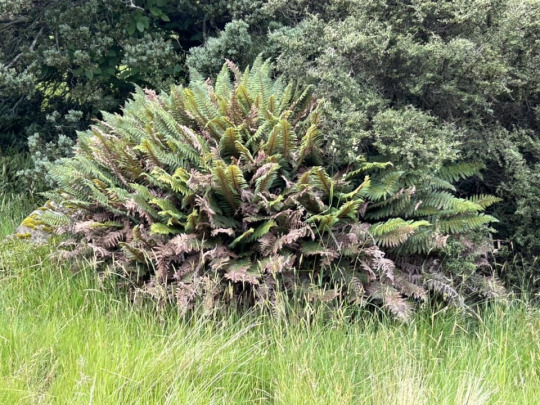
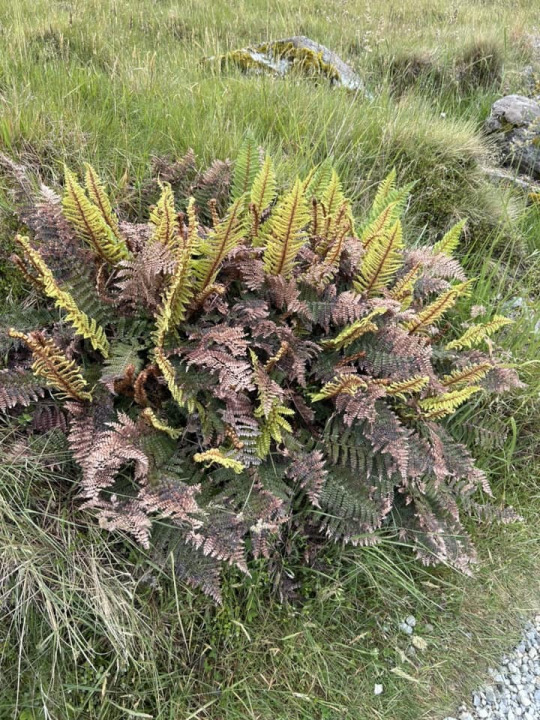

Also known as pūnui. Polystichum refers to the parallel rows of spore cases on the underside of the fronds, and vestitum (Latin for "clothed") denotes the dense cover of the scales on its leaf stalks. Fronds grow up to 600mm in length.
An evergreen or semi-green, cold-tolerant fern most common on New Zealand’s South Island, and a wide spread of Subantarctic islands.
In the northern part of its range P. vestitum is confined to montane regions or where temperature inversions keep the climate cold, but further south it can grow right down to the coast. Found in exposed habitats, such as forest margins, gulley floors and tussock grasslands, but it also commonly extends into forest in colder, wetter parts of New Zealand. On Macquarie Island it dominates the fernbrake communities, but is severely threatened by rabbits.
These ones were high in the middle of the South Island near Aoraki Mount Cook. It can be grown in cultivation, quite easily, but it slow to establish. Insect predators of the fern include the the tiny caterpillar of the "pūnui spore-eater", the "pale fern looper", and the "zigzag fern looper".
13 notes
·
View notes
Text
Bindae-ddeok from scratch
When I went to Korean in 2017, I tried Korean mung bean pancake at Gwangjang Market, one of THE largest & most famous markets in Korea. Pretty sure it was featured on some Netflix show. Anyway, one of the items the market is known for is this mung bean pancake, called bindae-ddeok in Korean. Koreans especially love eating this on rainy days with a bowl of makgeolli (Korean rice wine).
Bindae-ddeok is not only NOT popular here but it also does not even exist on restaurant menus. The taste & texture are both not appealing to the mass public here I guess. Acquired taste, you know? I recently watched a video where the guy was eating this so I decided to make it at home!

1st you’ll need this: mung bean!
This is a dry lentil; & I got it from Hmart.
There are many variations to this pancake but you definitely need the mung bean, hence the name :P
As for the rest of the ingredients & amounts . .. *shrugs* I didn’t really follow any particular recipe but kind of just took a little bit from each recipe that I read so. .. yeaaahhh let’s do it!

Rinse & soak the mung bean for a minimum of 6 hrs (preferably overnight, which was what I did). Ohhhh mannn there was so much starch coming off the beans. I’ve never used mung bean before; there was like more starch than rice.

A few of the recipes mentioned adding glutinous rice to the mung bean (& soaking it together), so I added some too. This was roughly a 4:1 ratio between the mung bean & the rice.

* 10 hrs later * .. they bloated a little bit but definitely softened.
Rinse a few times, & drain.

This is the other ingredient that needs to be soaked overnight. You don’t HAVE to but it takes a long time to cook otherwise so it’s better to soak/soften them up, & then cook.

You’ll have need bean sprouts.

So the fernbrake (cooked & chopped), mung bean, & bean sprouts (blanched & coarsely chopped) are absolutely needed for bindae-ddeok.
I added a small amount of onion bcos I didn’t have kimchi of any sort at home. The onion (/kimchi) will give the pancake a little bit of crunch.
Here is the most time consuming part...... the mung bean-rice mixture needs to be blended into a lumpy solution.

I don’t have a big blender so I had to use this small blender & blend in batches.. .

The result should be a slightly lumpy & thick ‘paste’.

I knew at this point I had failed - mine was too watery =(

Added all the other stuff to it. I tried to “save” it with an egg, & I think I’ve semi-succeeded. The thing is. .. the bean sprouts let out water over time so you gotta account for that.

Pan-frying . . . at the markets, it’s like deep-fried. Almost. There’s a LOT of oil, but like I mentioned in previous posts, I’m limiting the oil amount.

This 1st one wasn’t as golden brown as I would have liked so I adjusted my heat & oil accordingly. ..

Eventually, I did get a nice golden, crunchy pancake. It takes about 3-4mins per side but it will vary depending on thick your pancake is.

TA-daaaa~
Taste - [Sorry, I forgot to say .. I also added salt & a little of bit beef stock powder as the seasoning in my batter earlier] Overall, a bit bland, but can use dipping sauce on the side. I’d always rather have something more bland than too salty. It was heavy on the fernbrake flavour as expected.
Texture - crunchy (from the bean sprouts) with some chewy bits (the fernbrake) & not very bean-y, you know what I mean? I mean, it was kind of mushy/bean-y but definitely not near the same extent as the ‘professional’ ones. I partially think my pancakes were too thin; I did it to save some cooking time.
Would I make again?
Yes, but not often haha it’s too much work & I need to have bean sprouts around for this, which isn’t something I normally have. I really need to plan it out, especially with the overnight soaking for the ingredients.
2 notes
·
View notes
Text
youtube
Bibimbap
비빔밥
Rice mixed with vegetables, meat, an egg, and chili pepper paste
Today’s recipe is bibimbap, a super-popular Korean dish you might have heard about already! It’s made of a bowl of rice, sautéed and seasoned vegetables (namul: 나물), a bit of hot pepper paste (gochujang: 고추장), and usually a bit of seasoned raw beef, too (yukhoe: 육회).
Bibim (비빔) translates as “mixed,” and bap (밥) means “cooked rice,” so bibimbap literally means “mixed rice.” Before eating it you’re supposed to mix everything all together.
There are many variations on this dish, from simple to elaborate, and this recipe I’m showing you today is for one you could consider “classic” bibimbap. If you ordered bibimbap in a Korean restaurant, you would probably get something like this dish, with regional variations. I’m also going to show you bibimbap prepared and served in a heated stone or earthenware bowl called dolsot-bibimbap (돌솥비빔밥). “Dolsot” means “stone pot” in Korean, and this version is well-known for the way the bowl makes a layer of crispy, crackling rice on the bottom of the bibimbap.
Even though we mix up bibimbap before we eat it, each ingredient needs to be prepared with care and individuality, bringing out their unique flavors, textures and colors so they come together beautifully in the bowl and deliciously in your mouth. The different ingredients aren’t random, they’re chosen because they balance, harmonize, and offset each other.
This recipe isn’t quick and easy, it takes some time to make. But if you’re really in a rush you can make a great bibimbap with the soybean sprouts, spinach, and carrot (or red bell pepper, or both), and gochujang, toasted sesame oil, and an egg— those items are unskippable!
I’m going to share some more bibimbap recipes on my website in the future, and you’ll see how many different variations there are. This version is a little different than the version in my cookbook, because I make a quick and simple soup with the bean sprouts. When I started my YouTube channel, bibimbap was one of the first recipes I made, because it’s such an essential dish in Korean cuisine. So I’m happy to remake the video now in HD with much better editing and instruction. I’ve been building up to this video by remaking videos for the ingredients, too. I remade yukhoe, and sigeumchi-namul, and my yukagaejang video has a lot of detail about preparing the mountain vegetable fernbrake.
So if you’ve been following my videos, you’re now ready to be a bibimbap master! Ready? Let’s start!
Ingredients (serves 4)
5 cups cooked short-grain rice
12 ounces soy bean sprouts, washed and drained
8 ounces of spinach blanched and washed with the excess water squeezed out by hand
1 large carrot
1 large red bell pepper
1 large zucchini
1 English cucumber
3 to 4 green onions, chopped
½ pound fresh lean cut of beef (fillet mignon, flank steak)
4 ounces fernbrake (gosari), fresh or soaked from ½ ounce dried gosari (details below)
1 ounce dried bellflower roots (doraji), soaked in cold water for 18 to 24 hours.
4 eggs
kosher salt
vegetable oil
toasted sesame oil
toasted sesame seeds
garlic
soy sauce
honey (or sugar)
Korean hot pepper paste (gochujang)
How to prepare dried fernbrake (gosari) for use
If you have presoaked or fresh fernbrake you can use it straight away, but if you have dried fernbrake you’ll need to get it ready to eat. It’s fast if you have a pressure cooker, but if you don’t it will take some time.
With a pressure cooker:
Wash ½ ounce of dried gosari and boil it with 5 cups of water in a pressure cooker for 30 minutes.
Drain and rinse in cold water a couple of times.
Drain. It should make 4 ounces.
In a pot on the stove:
In a large saucepan add ½ ounce of dried gosari to 7 cups of water. Bring to a boil over medium-high heat and boil for 30 minutes. Cover and let stand until cool, about 2 to 3 hours.
Rinse the fernbrake a couple of times, drain and put in a bowl. Cover with fresh cold water and let soak for at least 8 hours or overnight in a cool place, changing the water 2 or 3 times during the soaking.
Taste the gosari: It should be soft. If it’s tough, boil it again in a fresh pot of water for about 20 minutes and then let it sit, covered, until soft.
Drain. It should make 4 ounces.
Make rice
If you have a usual method for making rice or have a rice cooker, go ahead and make 5 cups of rice like you usually do. But here’s how I do it on a pot on the stove. 2 cups of dried rice makes about 5 cups of cooked rice.
Rinse 2 cups of rice in cold water and scrub the wet rice with your hand. Rinse and drain until the drained water is pretty clear.
Put the rice in a heavy-bottomed pot. Add 2 cups of water, cover, and soak for 30 minutes.
Cook over medium high heat for 7 to 8 minutes until the surface is covered with abundant bubbles that are spluttering noisily and look like they’re about to overflow the pot. Turn the rice over a few times with a spoon and cover the pot again.
Turn the heat to very low and simmer for another 10 minutes until the rice is fully cooked and fluffy. Remove from the heat.
Fluff the rice with a spoon to release excess steam. Let the rice stand, covered, at room temperature to keep it warm.
Prepare and cook the ingredients for bibimbap
I like to get a big platter and then put each vegetable on it as they’re ready. I think it looks really pretty, but you don’t have to do this. When all vegetables are prepared and ready to use, the platter looks pretty delicious!
Soybean sprouts:
Put the soy bean sprouts in a pot and add 4 cups water and 2 or 3 teaspoons salt. Cover and cook for 20 minutes over medium high heat. Take out the sprouts with tongs and put them into a bowl, leaving about ½ cup of sprouts in the pot with the water you used to boil them. This is the soup to serve with bibimbap later.
In a bowl, mix the sprouts by hand with ½ teaspoons salt, 1 teaspoon minced garlic, and 2 teaspoons toasted sesame oil. Put them on the large platter.
Spinach:
Cut up the blanched spinach a few times and put it in a bowl. Mix by hand with 1 teaspoon garlic, 1 teaspoon toasted sesame oil, ½ teaspoon kosher salt, and 1 teaspoon sesame seeds. Cover and put it next to the soy bean sprouts on the platter.
Other fresh vegetables:
Cut the carrot into matchsticks, put them in a bowl, and mix with a pinch of salt. Let stand for 5 to 10 minutes until sweating.
Cut the red bell pepper into halves, deseed, and slice into strips. Put them in a bowl.
Cut the zucchini into matchsticks and mix with ½ teaspoon kosher salt.
Cut the cucumber into halves lengthwise and slice thinly crosswise. Mix with ¼ teaspoon kosher salt.
Beef:
Cut the beef into matchsticks and put them in a bowl.
Mix with 1 tablespoon minced garlic, 1 tablespoon soy sauce, 1 tablespoon honey, 2 teaspoons toasted sesame oil, and 1 teaspoon sesame seeds with a spoon.
Cover and keep in the fridge until ready to use.
Mountain vegetables:
Cut the fernbrake (gosari) a few times into bite size pieces. Set aside.
Put the bellflower roots (doraji) in a large bowl. Add 1 or 2 tablespoons salt. Rub for a minute to wilt slightly and release some of the bitterness. Rinse them in cold water a couple of times and drain. If you find some roots are too thick, split them lengthwise. Set aside.
Let’s cook!
Heat up a pan over medium high heat. Squeeze out excess water from the carrot. Add a few drops of cooking oil to the pan and sauté the carrot for 1 minute. Put it on the platter next to the soy bean sprouts and spinach. Clean the pan with wet paper towel or wash it.
Heat a few drops of cooking oil in the pan and squeeze out the excess water from the cucumber. Sauté with ½ teaspoon minced garlic and a few drops of toasted sesame oil for 30 seconds. Put it on the platter. Clean the pan.
Heat up the pan with a few drops of cooking oil. Add the red bell pepper and sprinkle a pinch of salt over top. Sauté for 30 seconds. Put it on the platter. Clean the pan.
Heat up the pan and squeeze out excess water from the zucchini. Add a few drops of cooking oil and sauté with 1 teaspoon minced garlic, 1 tablespoon chopped green onion, a drop of toasted sesame oil for 1 minute until slightly softened. Put it on the platter. Clean the pan.
Heat up the pan with a few drops of cooking oil. Add the bellflower roots and sauté for 2 to 3 minutes. Lower the heat to medium so as not to brown them. Add 1 teaspoon minced garlic and a drop of toasted sesame oil. Stir for another minute until a little softened. Put it on the platter. Clean the pan.
Heat up the pan. Add a few drops of cooking oil. Stir the gosari for 2 minutes until a little softened. Add ½ teaspoon of minced garlic, 2 teaspoons soy sauce, and 2 teaspoons sugar, and keep stirring for another minute. Put it on the platter.
Serve
Here are a couple of ways to serve: bibimbap in a regular, shallow bowl, and dolsot-bibimbap in a stone or earthenware bowl.
In a regular, shallow bowl
Reheat the soybean sprout soup.
Divide the cooked rice into 4 portions. Each portion will be a little more than 1 cup of rice.
Put the rice in each of 4 bowls and arrange the vegetables and beef on the rice. Top with a raw egg yolk and gochujang. If you prefer your eggs and beef cooked, use a fried egg sunny side up and slightly pan-fry the beef before putting them on the top of rice.
Sprinkle the bibimbap with the sesame seeds and drizzle with sesame oil to taste.
Ladle the soup to a small bowl and sprinkle some chopped green onion over top.
Serve right away with more hot pepper paste on the side, and maybe kimchi too.
Dolsot-bibimbap in a hot earthenware bowl (ttukbaegi) or hot stone bowl (dolsot)
Reheat the soybean sprout soup.
Put a few drops of toasted sesame oil in the bottom of each of 4 earthenware bowls. They should be big enough to hold 4 to 6 cups each.
Divide the rice among the bowls. Arrange the vegetables and beef on the rice. Top each serving with a raw egg yolk and 1 tablespoon gochujang. If you prefer your eggs and beef cooked, use a fried egg sunny side up and slightly pan-fry the beef before putting them on the top of rice.
Set each pot on a burner. Heat over medium high heat until you hear a ticking, crackling sound coming from the rice.
Sprinkle the bibimbap with the sesame seeds, drizzle with sesame oil to taste.
Ladle the soup to a small bowl and sprinkle some chopped green onion over top.
Serve right away with more hot pepper paste on the side and maybe kimchi too.
Eat
Gently but firmly mix everything together in the bowl with your spoon. Try not to crush the more delicate ingredients.
Eat with your spoon.
Posted on Sunday, January 6th, 2008 at 11:14 pm. Last updated on September 18, 2022.
#bibimbap#bibimbap recipe#dolsot bibimbap#돌솥비빔밥#비빔밥#homemade bibimbap#hot stone bowl bibimbap#how to eat bibimbap#how to make bibimbap#how to make dolsot bibimbap#Korean earthenware bowl bibimbap#korean food#Korean Mixed Rice with Meat and Assorted vegetables#Korean mixed rice with vegetables and meat#Korean recipes#Korean stone pot bibimbap#rice mixed with vegetables#spicy mixed rice#stone bowl bibimbap#Youtube#kfood#korean#food#foodie#recipe#bts#rm#jin#suga#jhope
5 notes
·
View notes
Text
Watch "한국에서 고사리 제일 잘 꺾는 현란한 손놀림" on YouTube
youtube
Korean fernbrake / Gorari wild vegetable
0 notes
Text
Thank you! That's a relief, i also dont have any flagged posts anymore but tumblr still tells me I do 🤔🤔🤔

#like i click on the page and theres nothing#pupusukka#a-shrieking-cloud-of-bats#sassysassan#fernbrake
2 notes
·
View notes
Photo

고사리나물 / Gosari-namul / Stir-fried fernbrake side dish
1 note
·
View note
Link
Wonderful Vegan Food!
“Gosari-namul” or ‘stir fried Bracken’ is a Korean traditional side dish. If you gather young Gosari(bracken) in Spring and dry them, you can eat them all year round. It is a food not to be missed every holiday and ceremony, and it is also an important ingredients of yukgaejang and bibimbap. Some say Gosari has a ‘meat’ flavor and texture so Korean people ate them when they couldn’t afford to buy real meat like beef or pork. Gosari(Bracken) has a unique flavor, which fits well with soy sauce and sesame oil.
As it takes time to cook dried Gosari, Gosari Namul is recognized as difficult dish to make. However, American slow cookers make it much easier to cook Gosari. This is also the way I invented from living in the United States for 11 years. There are many Korean traditional foods that need a long cooking time, and it is interesting that you can easily cook most of them using American slow cookers.
#gosai namul#fernbrake#sitr-fried bracken#vegan#healthy food#korean cooking#slowcooker#namul#idea kitchen
1 note
·
View note
Text
6 Must Have Food On Chuseok
1. Songpyeon

Chuseok wouldn’t be the same without Songpyeon. These are small rice cake that are traditionally steamed on pine needles. They are shaped like crescent which symbolises future prosperity and come in vibrant colors such as pink, orange, and green. Songpyeon is usually served for dessert as they contain sweet filling like red beans or brown sugar.
2. Pajeon
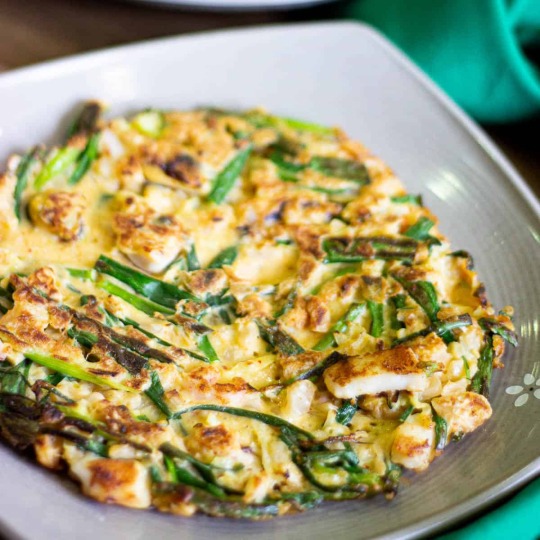
While commonly referred to as Korean Scallion pancakes, the word pajeon actually comes from pa meaning scallions and jeon which refers to food that is pan-fried in batter. Although there are different types of pajeon such as the haemul pajeon (seafood scallion pancakes), the plain version is traditionally served at Chuseok. It is best eaten with a simple dipping sauce made of soy sauce, vinegar and toasted sesame seeds.
3. Perilla Leaf Jeon
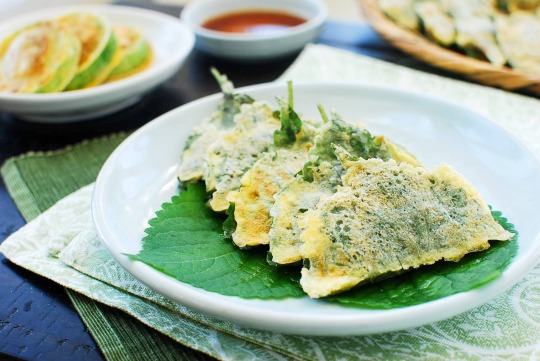
Perilla leaf jeon consists of meat filling wrapped in a perilla leaf that is folded into half and then dipped into a seasoned egg batter before pan frying. Perilla leaves are type of herb that is commonly eaten with meat at places like Korean barbeque restaurants. Its minty taste help balance the greasiness of barbequed meat.
4. Wanjajeon

Wanjajeon are mini meat patties made of beef, pork, or both that are dripped into egg batter and then pan fried. Korean often call these dong-geu-rang-ttaeng which roughly translates to “circle coin” due to its small and round appearance. While wanjajeon was customarily only eaten during festive season like Chuseok, it is commonly included in everyday lunch boxes nowadays.
5. Galbijjim

Galbijjim refers to Korean braised short ribs. It is often made with beef short ribs although pork ribs work just as well. While it was once regarded as a dish eaten only by the wealthy, today galbijjim can be eaten during festive holidays or special occasions such as birthdays and weddings.
6. Tri Colored Namul
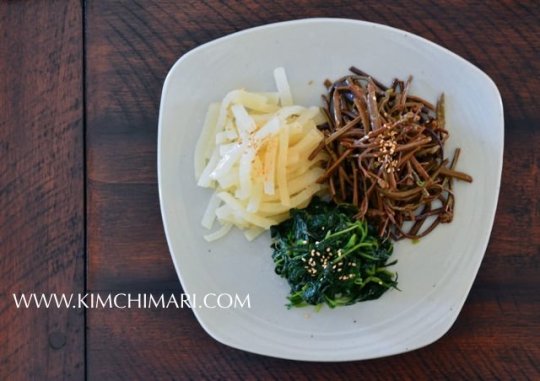
Namul refers to seasoned vegetables that are eaten as side dishes with regular meals. These serve to balance out the heavier dishes eaten during Chuseok. Tri-colored namul is made of different types of seasoned veggies in 3 colors - green, black, or brown, and white. The most traditional combination consists of sigeumchi namul (seasoned spinach), seasoned Korean bellflower roots and seasoned Korean bracken/fernbrake.
#south korea food#south korea culture#south korea cuisine#south korea chuseok#south korea holiday#south korea tradition#south korea facts#south korea guide#south korea headers#south korea life#south korea lifestyle#south korea eats#south korea tips#south korea vlog#south korea blog#south korea#korea tradition#korea food#korea holiday#korea chuseok#chuseok#korea facts#korea guide#korea headers#Korea holidays#Korea Life#korea lifestyle#korea eats#Korea Republic#korea tips
15 notes
·
View notes
Photo


collaboration with @fernbrake for the last day of janurwby! i did the lineart for blake, she did the lineart for yang, and we colored each others
260 notes
·
View notes
Text
Starfall Celebration skin submissions

Arcane Alterations by Saerino

Portalguard by Bluedragon

Novatorn by bioluminosity

Accent: Lunar Vision by dracozolt

Spellcaster's Hubris by Goblincat

Starwood Curse by Phenri


Flower Moon and Andromeda by Sandcastle

Accent: Celestial Goddess by ravenistic

Accent: Cosmos Keeper by Fernbrake

Crystal Spinocturne by Desnik

Mage Hand by shroudrat

AreoPlaine by RubieKanary

Dreamland by Kaohgumy

Accent: Nebubyla Harnesser by Moonbriar

Smudged Starlight by Zihette

The Astronavigator by Straka

Rift Guard by Catfeather

Crystallized Runes by emyon

Arc Construct by Passenger

Arcanospectre by Echinoderma

justa causa by nullius

Starwood Glass by Eversnow

magician's familiars by bothriolepis

Sweet Star Fae by protowilson


Starlit Traveler and Cosmic Defender by KingKichi

Forbidden Fragment by Cattestrophic

Starmaker by Kaenith
4 notes
·
View notes
Photo

ENTRY 1:
i am starting my digital journal here on this blog. i created this blog mainly to make a sort of k-pop journal kinda cataloging groups and artists i am a fan of. i will hopefully posting regularly if i can figure out how the queue posting works. i am planing on making digital journal pages in photoshop and posting them as images on here rather than typing as i am doing right now.
thanks,
FERNBRAKE
0 notes
Photo

🌿🍄KETO Spicy Korean Beef Stew (Vegan) - Yukgaejang typically is made with different beef brisket, fernbrake and shiitake mushrooms. Today I used oyster mushrooms and a few short cuts to turn this into a keto friendly spicy tofu soup that will soon become a staple dish in your household! 🥘 🔥 🌿 Ingredients Oyster mushrooms Shiitake mushrooms Tofu Leaks Green onions Gojuchang Dark Soy Sesame oil Garlic 🌶 serve with a side of homemade kimchi 🥬 🫰Tag a #spicyfood lover 👇👇👇 — — #instanomss #Yukgaejang #koreanfood #koreansoup #vegankorean #vegan #素食 #vegandinner #f52grams #vegandinnerideas #veganfoodblog #wholefoodplantbased #veganprotein #veganproteins #veganrecipeshare #plantbasedprotein #keto #ketolifestyle #ketodiet #spicy #spicyfoodid #spicygang #spicyfoods #redpepperflakes #koreanvegan #mushrooms #oystermushrooms #shiitake #tofurecipes (at Vancouver, British Columbia) https://www.instagram.com/p/CdWzqJoJ4ps/?igshid=NGJjMDIxMWI=
#spicyfood#instanomss#yukgaejang#koreanfood#koreansoup#vegankorean#vegan#素食#vegandinner#f52grams#vegandinnerideas#veganfoodblog#wholefoodplantbased#veganprotein#veganproteins#veganrecipeshare#plantbasedprotein#keto#ketolifestyle#ketodiet#spicy#spicyfoodid#spicygang#spicyfoods#redpepperflakes#koreanvegan#mushrooms#oystermushrooms#shiitake#tofurecipes
0 notes
Text
Gosari namul (Korean fernbrake sidedish)
Soaked another batch of fernbrake to make “gosari namul” (”gosari” is fernbrake in Korean, & “namul” is a general term for edible grasses/leaves).

Okay, so. .. the last time I used fernbrake was to make yookgaejang in the instant pot. They became so soft after being cooked for 25mins. However, on stovetop, I had totally underestimated how long it’d take to ‘cook’ the fernbrake =S it took a long time.............

. . . continue boiling on low-medium heat for like 1.5 hrs o_O

Anyway, after cooking till it’s almost ready, I took it out of the pot, got rid of the water in the pot, & then I added soy sauce, rice syrup, a little bit of water & sesame oil to braise the fernbrake for another ~30mins or so.

Close to 2 hrs of cooking, this sidedish is done~

Sprinkled some sesame seeds on top before serving.
This can be served hot(/warm) or cold. I’ve tried it both ways & I prefer the cold version more. Or maybe bcos I had it cold overnight, so I ate it when it was shortly out of the fridge. I don’t know... when it was fresh & warm, the fernbrake was soft. After being chilled, the texture became a little more firm, & I found the flavour to be deeper/richer upon refrigeration. So up to you, I guess! Either way, it was delicious, & I will definitely make this again!
0 notes